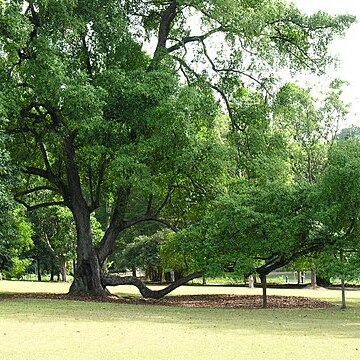Tree (sometimes a shrub), 8-25(-55) m tall, up to 1.35(-2.5) m ø, sometimes with buttresses up to 2½ m. Leaves petioled, oblong-lanceolate to lanceolate or obovate-oblong, 4-15 by 1.5-6 cm, mostly thinly, rarely firmly coriaceous, sometimes more or less bullate, the base acute or shortly attenuate, the apex rarely blunt to acute, usually short-to long-acuminate, sometimes to caudate, obtuse; nerves 4-9 pairs, rarely more or fewer, sunken above, slightly prominent or invisible beneath; petiole thin, 1-2.5 cm; axillary scale rounded, c. 1-2 mm long, partly free from the petiole. Inflorescences in the higher leaf-axils, (1-)3-to ∞-flowered, often rather dense; peduncle thin, 1.5-7.5 cm; pedicels thin, 0.5-2.5 cm, often with 2 minute bracteoles in or below the middle (in few-flowered inflorescences sometimes with a second pair near the base). Calyx campanulate, 2.5-8 mm long, divided over 1/3-3/4 of its length. Corolla-tube narrowly funnel-shaped, 0.75-2.25 cm. Anthers oblong-linear to oblong-elliptic, 1.75-3 mm long, cells free in the basal half. Style 1.25-6 cm long; stigma small, capitate or obconical, faintly 2-lobed. Berry broadly ellipsoid, tipped by the short but distinct style-rest, 0.75-1 cm ø, red or orange.
More
A tree. It grows 10-25 m tall. It usually has an irregular shape. The trunk is dark brown with deeply cracked bark. The leaves are oval and light green. The flowers are yellow. The flowers unfurl at sunset and have a strong scent. The fruit are red berries.
Humid, often seasonally but not constantly swampy, light forest, secondary forests, lalang fields, in the Malay Peninsula also along the beach; it does very well in poorly aerated, compact or swampy soils, but also on poor sands or podsols; from sea-level up to c. 800 m.
More
Light primary and secondary forest in humid or seasonally inundated locations, avoiding stagnant water. In freshwater-swamp forest, found in association with Melaleuca spp. Also occurs naturally as a pioneer in burnt-over areas and lalang grassland.
It is a tropical plant. It can grow in poor soils including poorly-aerated and poorly-drained soils. At FRIM in Malaysia.
Uses. This beautiful tree is often planted, especially along roads and as a shade tree, mainly in Siam, Sumatra, Singapore, and locally in Java. Furthermore it is commonly planted for reforestation, as the timber is highly valued, being hard and very durable — even in the soil or in water — though not very beautiful, see SCHNEIDER Bull. Bur. For. Philip. 14 1916 202 f. 71 . A decoction of the bark is used as a febrifuge, e.g. for malaria, a decoction of the leaves and twigs is drunk in Kedah, Malaya, for passing blood in stools, such as happens in dysentery.

